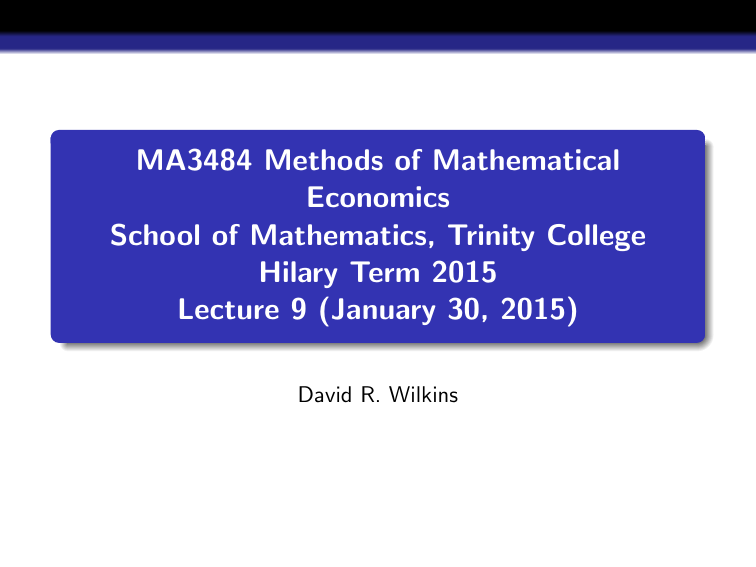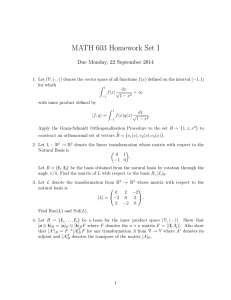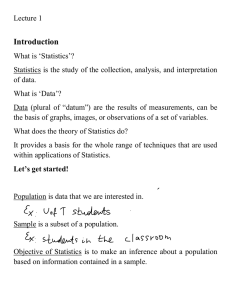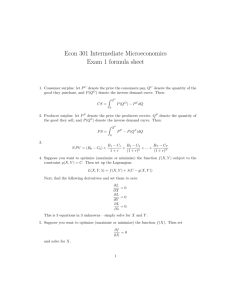MA3484 Methods of Mathematical Economics School of Mathematics, Trinity College Hilary Term 2015
advertisement

MA3484 Methods of Mathematical
Economics
School of Mathematics, Trinity College
Hilary Term 2015
Lecture 9 (January 30, 2015)
David R. Wilkins
The Transportation Problem: the General Algorithm
We now describe in more generality the method for solving the
Transportation Problem, in the case where total supply equals
total demand.
Thus we suppose that we have m suppliers and n recipients. The
ith supplier can provide at most si units of a commodity, and the
jth recipient requires dj units, where si ≥ 0 for all i, dj ≥ 0 for all j
m
n
P
P
si =
dj . The cost of transporting the commodity from
and
i=1
j=1
the ith supplier to the jth recipient is ci,j . It is required to
determine the amount xi,j of the commodity that should be
transported from the ith supplier to the jth recipient, consistent
n
P
with the constraints that xi,j ≥ 0 for all i and j,
xi,j = si for
j=1
i = 1, 2, . . . , m,
m
P
i=1
xi,j = dj for j = 1, 2, . . . , n.
The Transportation Problem: the General Algorithm
A set of quantities
(xi,j : i = 1, 2, . . . , m, j = 1, 2, . . . , n)
satisfying these constraints is a feasible solution to the problem.
m P
n
P
The cost of a feasible solution (xi,j ) is
ci,j xi,j . An optimal
i=1 j=1
solution to this transportation problem is a feasible solution to the
problem whose cost does not exceed that of any other feasible
solution.
The Transportation Problem: the General Algorithm
As usual, we denote by Mm,n (R) the set of all m × n matrices with
real coefficients, we denote by ρ : Mm,n (R) → Rm and
σ : Mm,n (R) → Rn the linear transformations defined such that
m
n
P
P
(X )i,j for
(X )i,j for i = 1, 2, . . . , m and σ(X )j =
ρ(X )i =
i=1
j=1
j = 1, 2, . . . , n, we denote by W the set of all ordered pairs (s, d),
m
n
P
P
where s ∈ Rm , d ∈ Rn and
(s)i =
(d)j , and we denote by
i=1
j=1
θ : Mm,n (R) → W the linear transformation from Mm,n (R) to W
defined such that θ(X ) = (ρ(X ), σ(X )) for all X ∈ Mm,n (R). Then
n
m
X
X
θ(X ) = (X )i,j ,
(X )i,j .
j=1
i=1
The Transportation Problem: the General Algorithm
Let I = {1, 2, . . . , m} and J = {1, 2, . . . , n}. Each subset K of
I × J determines a corresponding subspace MK of the real vector
space Mm,n (R), where
MK = {X ∈ Mm,n (R) : (X )i,j = 0 when (i, j) 6∈ K }.
The real vector space MK is of dimension |K |, where |K | denotes
the number of elements in the subset K of I × J. The linear
transformation θ : Mm,n (R) → W restricts to a linear
transformation θK : MK → W .
A subset B of I × J is a basis for the transportation problem if and
only if the corresponding linear transformation
θB : MB (R) → W
is an isomorphism.
The Transportation Problem: the General Algorithm
Proposition
Proposition TP-G01 Let X , C and Q be m × n matrices with
real coefficients, and let u1 , u2 , . . . , um and v1 , v2 , . . . , vn be real
numbers. Suppose that
(C )i,j = vj − ui + (Q)i,j
for i = 1, 2, . . . , m and j = 1, 2, . . . , n. Then
trace(C T X ) =
m
X
i=1
where ρ(X )i =
n
P
n
X
ui ρ(X )i + trace(Q T X ),
j=1
(X )i,j for i = 1, 2, . . . , m and σ(X )j =
j=1
for j = 1, 2, . . . , n.
vj σ(X )j −
m
P
(X )i,j
i=1
The Transportation Problem: the General Algorithm
Proof
Let xi,j = (X )i,j , ci,j = (C )i,j and qi,j = (Q)i,j for i = 1, 2, . . . , m
and j = 1, 2, . . . , n. Then ci,j = vj − ui + qi,j for 1 ≤ i ≤ m and
1 ≤ j ≤ n, and therefore
The Transportation Problem: the General Algorithm
T
trace(C X ) =
m X
n
X
ci,j xi,j =
i=1 j=1
=
n
X
vj
j=1
m X
n
X
m
X
!
xi,j
−
i=1
+
(vj − ui + qi,j )xi,j
i=1 j=1
m X
n
X
m
X
i=1
ui
n
X
xi,j
j=1
qi,j xi,j
i=1 j=1
=
m
X
i=1
as required.
vj σ(X )j −
n
X
j=1
ui ρ(X )i + trace(Q T X ),
The Transportation Problem: the General Algorithm
Corollary
Corollary TP-G0X Let m and n be integers, and let
I = {1, 2, . . . , m} and J = {1, 2, . . . , n}. Let X and C be m × n
matrices, and let u1 , u2 , . . . , um and v1 , v2 , . . . , vn be real numbers.
Suppose that (C )i,j = vj − ui for all (i, j) ∈ I × J for which
(X )i,j 6= 0. Then
trace(C T X ) =
m
X
i=1
where si =
n
P
dj vj −
n
X
s i ui ,
j=1
(X )i,j for i = 1, 2, . . . , m and dj =
j=1
j = 1, 2, . . . , n.
m
P
(X )i,j for
i=1
The Transportation Problem: the General Algorithm
Proof
Let Q be the m × n matrix defined such that
(Q)i,j = (C )i,j + ui − vj for all i ∈ I and j ∈ J. Then
(C )i,j = vj − vi + (Q)i,j for all i ∈ I and j ∈ J, and Qi,j = 0
whenever (X )i,j 6= 0. It follows from this that
m X
n
X
trace(Q X ) =
(Q)i,j (X )i,j = 0.
T
i=1 j=1
It then follows from Proposition TP-G01 that
T
trace(C X ) =
m
X
i=1
as required.
dj vj −
n
X
j=1
s i ui ,
The Transportation Problem: the General Algorithm
Proposition
Proposition TP-G0Y Let m and n be integers, let
I = {1, 2, . . . , m} and J = {1, 2, . . . , n}, and let B be a subset of
I × J that is a basis for the transportation problem with m
suppliers and n recipients. For each (i, j) ∈ B let ci,j be a
corresponding real number. Then there exist real numbers ui for
i ∈ I and vj for j ∈ J such that ci,j = vj − ui for all (i, j) ∈ B.
Moreover if u i and v j are real numbers for i ∈ I and j ∈ J that
satisfy the equations ci,j = v j − u i for all (i, j) ∈ B, then there
exists some real number k such that u i = ui + k for all i ∈ I and
v j = vj + k for all j ∈ J.
The Transportation Problem: the General Algorithm
Proof
Let
(
W =
m
n
(s, d) ∈ R × R :
m
P
(s)i =
i=1
n
P
)
(d)j
,
j=1
let
MB = {X ∈ Mm,n (R) : (X )i,j = 0 when (i, j) 6∈ B},
let θ : Mm,n (R) → W be defined so that θ(X ) = (ρ(X ), σ(X )),
n
m
P
P
where ρ(X )i =
(X )i,j for i = 1, 2, . . . , m and σ(X )j =
(X )i,j
j=1
i=1
for j = 1, 2, . . . , n, and let θB : MB → W be the restriction of
θ : Mm,n (R) → W to MB .
The Transportation Problem: the General Algorithm
Let f : MB → R be the linear transformation from MB to R
defined such that
X
f (X ) =
ci,j (X )i,j
(i,j)∈B
for all X ∈ MB . The requirement that B be a basis for the
transportation problem ensures that θK : MB → W is an
isomorphism. It follows that there is a well-defined linear
transformation g : W → R from W to R that satisfies
f (X ) = g (θB (X )) for all X ∈ MB . Indeed g = f ◦ θB−1 .
The Transportation Problem: the General Algorithm
For i = 1, 2, . . . , m and j = 1, 2, . . . , n let E (i,j) denote the matrix
whose coefficient in the in the ith row and jth column has value 1
and whose other coefficients are zero, let b(i) denote the vector in
Rm whose ith component has the value 1 and whose other
components are zero, and let b(j) denote the vector in Rn whose
jth component has the value 1 and whose other components are
zero. Then θB (E (i,j) ) = β (i,j) for all (i, j) ∈ B, where
β (i,j) = (b(i) , b(j) ). It follows that
g (β (i,j) ) = g (θ(E (i,j) )) = f (E (i,j) ) = ci,j
for all (i, j) ∈ B.
The Transportation Problem: the General Algorithm
Let (s, d) ∈ W , where
s = (s1 , s2 , . . . , sm )
Then
s1 =
and d = (d1 , d2 , . . . , dn ).
P
n
dj
j=1
n
P
j=1
dj −
if m = 1,
m
P
si
if m > 1,
i=2
and therefore
(s, d) =
n
X
j=1
dj (b(1) , b(j) ) −
m
X
s=1
si (b(1) − b(i) , 0).
The Transportation Problem: the General Algorithm
Moreover (b(1) − b(i) , 0) ∈ W for i = 1, 2, . . . , m, and
(b(1) , b(j) ) ∈ W for j = 1, 2, . . . , n.
Let ui = g (b(1) − b(i) , 0) for i = 1, 2, . . . , m and vj = g (b(1) , b(j) )
for j = 1, 2, . . . , n. Then
g (s, d) =
=
n
X
j=1
n
X
j=1
(1)
dj g (b
(j)
,b ) −
m
X
s=1
vj dj −
m
X
i=1
ui si .
si g (b(1) − b(i) , 0)
The Transportation Problem: the General Algorithm
Moreover u1 = 0, and
vj − ui
= g (b(1) , b(j) ) − g (b(1) − b(i) , 0)
= g (b(1) , b(j) ) − (b(1) − b(i) , 0)
= g (b(i) , b(j) ) = g (β (i,j) )
= ci,j
for all (i, j) ∈ B.
The Transportation Problem: the General Algorithm
Now let u 1 , u 2 , . . . , u m and v 1 , v 2 , . . . , v n be real numbers with the
property that ci,j = v j − u i for all (i, j) ∈ B, let X ∈ MB , and let
(s, d) = θB (X ). Then X is an m × n matrix that satisfies
(X )i,j = 0 when (i, j) 6∈ B. Let C be a m × n matrix with
Ci,j = ci,j for all (i, j) ∈ B. It then follows from Corollary TP-G0X
that
g (s, d) = f (X ) = trace(C T X ) =
m
X
i=1
dj v j −
n
X
si u i ,
j=1
where si = (s)i for i = 1, 2, . . . , m and dj = (d)j for j = 1, 2, . . . , n.
The Transportation Problem: the General Algorithm
Now θK : MB → W is surjective, because B is a basis of the
transportation problem. It therefore follows that
m
X
dj v j −
i=1
n
X
si u i = g (s, d) =
j=1
m
X
dj vj −
i=1
n
X
si ui
j=1
for all (s, d) ∈ W .
Thus
n
X
j=1
v j dj −
m
X
i=1
u i si =
n
X
j=1
v j dj −
m
X
ui si
i=1
for all real numbers s1 , s2 , . . . , sm and d1 , d2 , . . . , dn that satisfy
m
n
P
P
si =
dj .
i=1
j=1
The Transportation Problem: the General Algorithm
On applying this result with appropriate choices of numbers si and
n
m
P
P
dj , we find that u i − u 1 = ui − u1 for
si =
dj satisfying
i=1
j=1
2 ≤ i ≤ m and v j − u 1 = vj − u1 for j = 1, 2, . . . , n. Thus
u i = ui + k for i = 1, 2, . . . , m and v j = vj + k for j = 1, 2, . . . , n,
where k = u 1 − u1 , as required.







